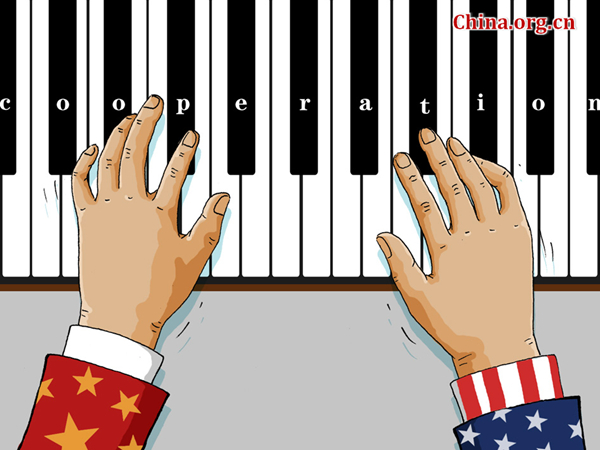The interconnected US-China trade and economic stakes
- By Zhang Lijuan and Robert Rogowsky
 0 Comment(s)
0 Comment(s) Print
Print E-mail China.org.cn, September 30, 2015
E-mail China.org.cn, September 30, 2015
|
|
|
Cooperative work [By Zhai Haijun/China.org.cn] |
The Chinese economy slowdown -- the "new normal" -- has been the focus of attention in the past few months. A good portion of Wall Street jitters have been attributed to worries about China's economic crash. Debate has heated up over how that will impact the U.S. economy.
With recent poor productivity numbers and weakening confidence in the U.S., mixed with geopolitical tensions and the normal rise of China-bashing in a Presidential election, it is certain that a better U.S.-China trade relationship will be good for both economies and for the rest of the world. Most Americans don't understand how deeply woven our economic relationship has already become, nor how much both sides are benefitting.
First of all, U.S. exports to China have tripled in the past ten years. In 2004, U.S. exports to China were $34.4 billion; in 2014 they reached $124 billion. China is the United States' fastest growing export market. No other nation or nations could possibly replace China's buying or importing potential in the coming decades. Most Americans would be surprised how much the Chinese consumers like "Made in USA" brands and products. Demand for U.S.-made goods is booming. It is not uncommon to see shoppers from China in American shopping malls.
Second, there is always a vast amount of U.S. local content in every "Made in China" product. According to Galina Hale and Bart Hobijn from the San Francisco Fed, on average, of every dollar spent on an item labeled "Made in China," 55 cents go for services produced in the United States. In other words, the U.S. content of "Made in China" is about 55 percent. The implication is clear: imports from China are creating jobs and helping grow the U.S. economy.
Third, China has one of the most complicated political economies in today's world. Debates on China's economic future never stop. But as Stephen Roach commented recently, most critics over-simplify the issue, and the fears are vastly overblown.
Chinese leaders made trade promotion and expansion the top priority in their economic agenda since the 1980s. Chinese economic growth was largely driven by exporting manufactured goods. It is shifting to a domestic consumption led growth model. In 2005, trade accounted for 63 percent of China's GDP. In 2014, it had fallen to 42 percent (albeit still heavily driven by substantial government investment). As China continues its transition, the trade-GDP ratio should eventually drop to 30 percent, which gets it close to the current U.S. trade to GDP ratio.






